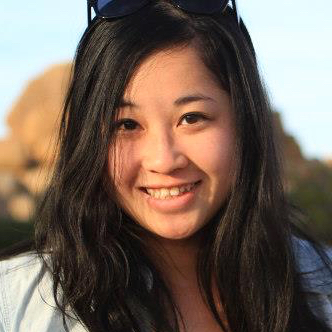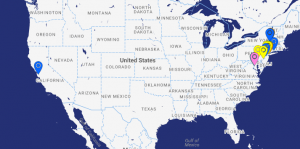SCOTUS Map: March and April 2017

on Apr 14, 2017 at 3:21 pm

Justice Sonia Sotomayor mingled with the crowd and dispensed advice to Stanford University students on March 10. “Figure out first how to be a generally informed citizen before specializing in anything else,” Sotomayor told them. “It might lead you to find an interest you can’t imagine. It will make you good company for others. If you tell interesting stories about interesting things, people will gravitate to you.” At the end of the talk, Sotomayor received a T-shirt bearing the words “Fear The Nerds” on the front and “#NerdUp” on the back. “I grew up being a nerd. Take pride in being nerds,” she remarked. Coverage of the event comes from Mercury News and Stanford University News. A brief video clip is available on abc7news’ website. C-SPAN will air the full program at 8 p.m. EDT today.
While Sotomayor was in Palo Alto, Chief Justice John Roberts was in New York to participate in a panel hosted by the U.S. Court of Appeals for the 2nd Circuit. The subject of the panel was Judge Henry Friendly, for whom Roberts clerked after graduating from law school. Roberts shared the stage with 2nd Circuit Judge Jon Newman and six fellow Friendly clerks, including Chief Judge Merrick Garland of the U.S. Court of Appeals for the District of Columbia Circuit. Roberts and Garland remembered Friendly as an “intellectual giant” and a “big-picture judge” who always walked his clerks through his reasoning process, even in the most mundane of cases. Garland — who worked for Friendly the year before Roberts did — joked at one point that he didn’t know how he had obtained his own clerkship, but he did know how Roberts got his, as Garland had called Harvard Law School on Friendly’s behalf to find the best student.
Roberts presided over a March 15 mock trial based on events in Mark Twain’s novel “The Adventures of Tom Sawyer.” Adam Liptak of the New York Times covered the proceedings, which were organized by the Washington University School of Law in St. Louis but took place at the Four Seasons Hotel in Washington.
On the same night, Justice Samuel Alito served as the featured speaker for a St. Paul Inside the Walls Advocati Christi event in New Jersey. According to the Associated Press, Alito spoke about both the history of discrimination that Catholics encountered in this country and his own personal experience of growing up Catholic. He recalled watching John F. Kennedy become the first Catholic president in 1960, when Alito was 10 years old: “I felt it had lifted me up from the status of second-class American.” Alito warned the audience, however, that today “a wind is picking up that is hostile to those with traditional moral beliefs.” The following week, Alito traveled to Pennsylvania to deliver a lecture about the Constitution at the Heritage Center of the Union League of Philadelphia.
Sotomayor spoke on the subject of civic engagement at the Aspen Institute on March 24. Asked about what people can do to “reignite civic spirit in America,” Sotomayor responded: “We are never going to reach equality in America — as Latinos, as blacks, as anything — until we achieve equality in education.” Sotomayor stressed the importance of teaching children to be active participants in their communities and promoted iCivics, an organization that retired Justice Sandra Day O’Connor founded (and for which Sotomayor serves as a board member) to provide civic education through games and other interactive tools. Video of the event is posted on YouTube.
On March 30, Justice Clarence Thomas addressed students at the 70th Annual Horatio Alger Awards and National Scholars Conference in Washington. A brief recap is available at the organization’s Facebook page.
On April 1, Sotomayor returned to Princeton University, where she received her undergraduate degree, for the “¡Adelante Tigres! Celebrating Latino Alumni at Princeton University” conference. The justice was candid about the insecurities she faced, both when she was a new student at Princeton and when she was nominated to the Supreme Court. Of the former, Sotomayor stated, “I had no idea about the prestige of Princeton or how I would be perceived here. I had no idea of the world I’d thrust myself into — I was a fish out of water.” Of the battle that surrounded her 2009 nomination, she recalled, “There were reports that I wasn’t smart enough, and there were reports that I was abrasive and not nice. Lots of negative stuff was said about me. And it was incredibly, incredibly painful. It hurt … And I actually, seriously thought about pulling out of the process.” Sotomayor credited her friends and her community with helping her press forward in both situations. Coverage comes from The Times of Trenton, CentralJersey.com, Princeton Alumni Weekly and The Daily Princetonian.
A couple of days later, Sotomayor arrived in upstate New York for a whirlwind tour, visiting three Albany-area schools and attending a portrait unveiling at the New York Court of Appeals. On April 3, Albany Law School honored Sotomayor with the Kate Stoneman Award, which is presented to those in the legal profession who have demonstrated a commitment to seeking change and equal opportunities for women. According to The Daily Gazette, Sotomayor described her efforts at making her writing accessible to a wide audience: “Most people don’t read our decisions. But I want to make sure that anyone who picks up one of mine, if you take the legal notes out, you don’t need more than a fifth-grade education to follow what I’m saying.”
Sotomayor did double duty on April 4, appearing at Russell Sage College in the morning and the University of Albany in the evening. The Troy Record covered the Russell Sage College appearance, where the justice emphasized the need for after-school programs: “When I am asked what we can do to change the lives of so many kids in our neighborhoods, I say, keep them busy after school.” WNYT has additional coverage and short videos from the event. The Legislative Gazette has a rundown of the University of Albany talk, and the university posted a brief video clip on its Twitter account.
New Haven was next on Sotomayor’s schedule. On April 6, she discussed her experiences with public interest work at the 20th Anniversary Liman Colloquium at Yale Law School. The following day, she attended another portrait unveiling – this time, her own. Yale Law School has a summary of the festivities.
All of the justices gathered in Washington on April 10 for the swearing-in of their newest colleague, Justice Neil Gorsuch. Roberts administered the constitutional oath of office to Gorsuch in a private ceremony in the justices’ conference room, which was followed by a second ceremony in the White House Rose Garden, with Justice Anthony Kennedy – for whom Gorsuch once clerked – presiding over the judicial oath. Coverage comes from SCOTUSblog, the New York Times, the Washington Post, USA Today and CBS News.
Later that afternoon, Allegheny College honored Justice Ruth Bader Ginsburg and the late Justice Antonin Scalia with its Prize for Civility in Public Life. (Scalia’s family accepted the award on his behalf at the ceremony.) “At my workplace, collegiality really matters,” Ginsburg told the audience. “We could not do the important work the Constitution assigns to the Court unless we genuinely respect each other.” SCOTUSblog and the Meadville Tribune posted recaps of her speech. Video of Ginsburg discussing her famous friendship with Scalia and her hope that members of Congress will restore “harmonious work ways” is available online.
At the Rensselaer Polytechnic Institute on April 11, Roberts offered up a sanguine vision of an apolitical court, stating that “[t]he new justice is not a Republican. He’s not a Democrat. He’s a member of the Supreme Court.” However, Roberts acknowledged, “It’s hard for people to understand that when they see the process that leads up to it … That’s very unfortunate, because we in the judiciary do not do our business in a partisan, ideological manner.” Roberts noted that since Scalia’s death, “the Supreme Court has been quietly going about its business of deciding the cases before it, according to the Constitution, in a completely nonpartisan way.” The Albany Times Union and the Washington Post covered Roberts’ talk. The school posted full video on its YouTube account.
Also on April 11, Alito adjudicated the inaugural Judge Leonard I. Garth competition, which presented a hypothetical First Amendment case before competing teams from Rutgers Law School’s Newark and Camden campuses. In his first year out of law school, Alito clerked for the moot court competition’s namesake.
On April 13, Justice Stephen Breyer gave the keynote address at the 43rd Annual Wolfgang Friedmann Conference at Columbia Law School. Breyer talked about his latest book, “The Court and the World.”
Next Thursday, Alito will be in Lancaster, Pennsylvania, for the 2017 Third Circuit Judicial Conference, where he will present the American Inns of Court Professionalism Award and participate in a fireside chat.


